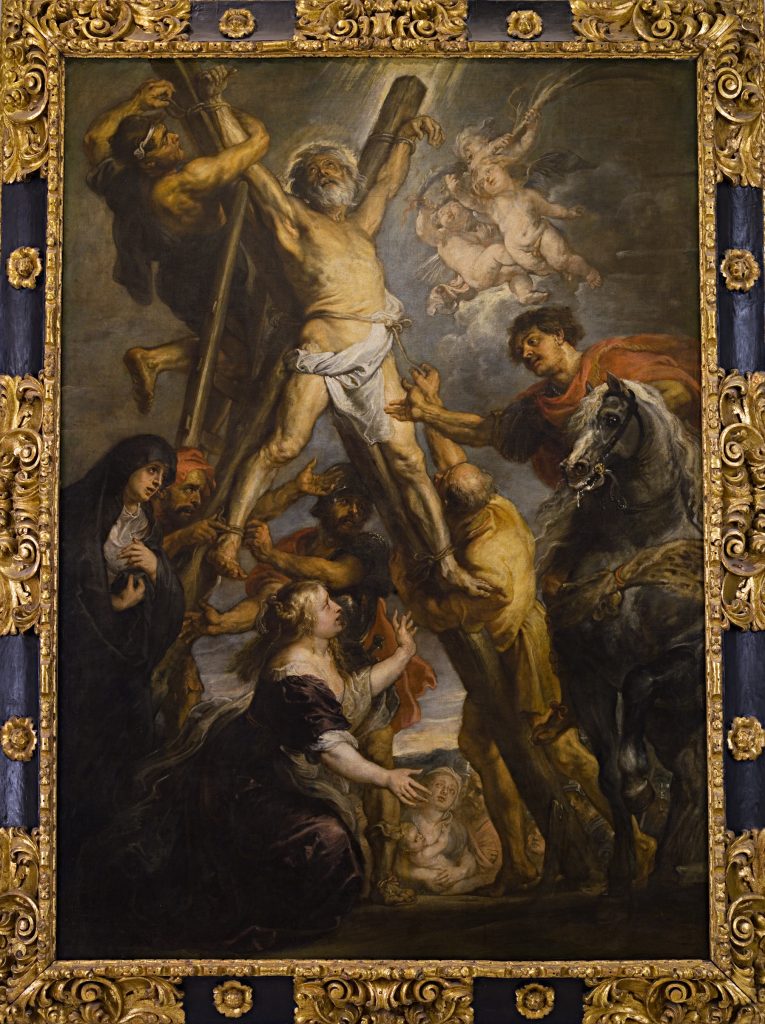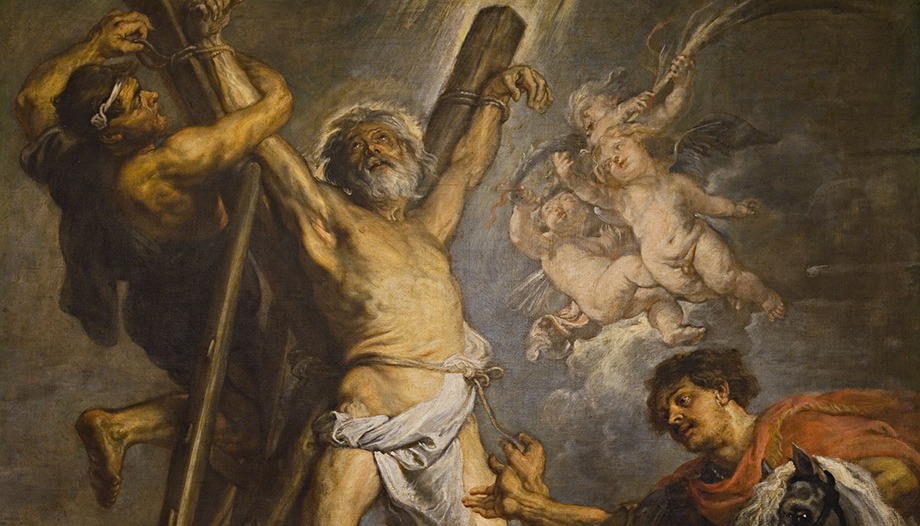The martyrdom of St. Andrewof Peter Paul Rubens was commissioned to the painter by Jan van Vucht, a Fleming who lived in Madrid and upon his death in 1639 bequeathed the painting to the Hospital de San Andrés de los Flamencos, now the Charles of Antwerp Foundation, founded in 1594 by Charles of Antwerp.
Charles of Antwerp who donated his goods to build a hospital to serve as lodging for the poor and pilgrims coming from the Netherlands. In 1617 the hospital and church were founded under the patronage of St. Andrew, patron saint of Burgundy and that had the royal protection since the seventeenth century.
When the hospital was suppressed in 1844, the canvas was deposited in the Monastery of El Escorial and also in the Royal Tapestry Factory, and in 1891, after the renovation of the hospital, it was again placed in the new chapel. Prado Museum and since 1989 it has been housed at the Carlos de Amberes Foundation.
The first time it was in a museum in Spanish America was in 2019, at the Museo Nacional del Barroco de Puebla de Zaragoza (Mexico).
It was exhibited at the National Museum of Art in Mexico in order to show the influence of Rubens on artists of New Spain such as José Juárez and Cristóbal de Villalpando.

Artistic background: Van Veen and Rubens
We include here the contribution of Inmaculada Rodríguez Moya in the volume Otto van Veen: Inventor and painter, between erudition and devotion: "At the end of 1594, Van Veen was commissioned to execute a new altarpiece at St. Andrew's in Antwerp with the theme of the saint's martyrdom.
At that time, after the reestablishment of Catholicism by Alexander Farnese, there was a predominant taste for the representation of martyrdom in Antwerp. Images of martyrs already existed, but from that time on they multiplied with a declamatory and monumental tone and emphasized expressions of instruments of torture and compositions full of figures and activity, of which Van Veen's altarpiece is an example. This was intended to provide models of imitation of the fortitude and courage that true Christians had to demonstrate in times of persecution.
The altarpiece represented the crucifixion of the saint in a main panel without wings and in the predella, scenes of the vocation of the apostles and Christ with the orb.
The artist has placed in the foreground a series of characters: weeping women and children, the Roman governor on horseback and the soldiers crucifying the saint. In the middle ground, but in the upper part of the canvas, that is, already in the celestial Glory, the cross is placed with the saint, whose body coincides completely with the position of the wood, facing the viewer. The saint is surrounded by angels, with the palm, the olive branch and the martyr's crown. In the background we see a circular templete and a door, serving the grisaille to place the lights of the scene.
In 1596 Van Veen executed the model on canvas following the composition of the sketch, complicating the composition by incorporating more characters and greater variegation. He modifies the lights, leaving the soldiers holding the cross in semi-darkness, to highlight the figures of the women, and the governor in the foreground. He further illuminates the background by backlighting these figures in the middle ground, creating a greater effect of depth.
In the last stage, in the panel, Van Veen's mastery in the treatment of chiaroscuro and color, and the predominant classicism of the work, is evident. The large panel emphasizes the isolation of St. Andrew with respect to the middle, symbolizing his ascension to Glory by his superior situation, by the golden light that emerges behind him, by his stoic serenity and that of the angels with crowns and the palm, and one of them helping the soldier to thrust the lance into the saint. Light and color with features and gestures of the weeping women and the indifferent soldiers, allow to create the desired devotional effect. The architecture of the background -circular temple and triumphal door- is further emphasized, creating a phantasmagoric effect and contributing to underline the extraordinary nature of the scene. The panel is intended to show us the heroic glorification of the martyr with the clear purpose of awakening the militant faith of the devotees.
Van Veen intended to highlight the crucifixion as a scene that would make an impression and overwhelm the viewer because of its size.
Rubens had a similar intention in the Martyrdom of St. Andrew (1639), a work of his final stage in which he was inspired by the composition of his master. Rubens creates an effect even more shocking than Van Veen, accentuating the diagonals of the composition, structured on the cross itself, which occupies the entire pictorial space and placing a few characters in the foreground (the governor on horseback and the weeping women on the same side as on the panel), the angels with the symbols of their glory and the muscular soldiers holding the cross), leaving the crowd in a much lower background line, although the effect of spiritual superiority of the saint and the effect of light and shadow sought by Rubens is very similar and even more spectacular than that of his master".
Mission and death of St. Andrew
St. Andrew, the second of the apostles, bears a Greek name which, according to Benedict XVI, is a sign of a certain cultural openness of his family.
Fruit of his first apostolic zeal, was his proselytizing conquest of Simon Peter. He interceded for the pagans before their time came, by interpreting, to a small group of Greeks, the prophecy about the extension of the Gospel to them.
"And in one of the lessons he applies to Andrew the words of the Letter to the Romans: "Everyone who calls on the name of the Lord will be saved. How will they - Jews and pagans - call on Him in whom they do not believe? And how will they believe in Him of whom they have heard nothing? And how will they hear without someone preaching to them? And I ask: Have they still heard nothing? But his voice has gone out into all the earth, and his words have reached to the ends of the earth," proclaims the breviary on its feast day.
The barbarians in their lands were recipients of his evangelical message, probably with Peter himself. Eusebius, father of the Church, places him apostolically in the wild Scythia, south of present-day Russia or in its border regions such as Bithynia, Pontus and, above all, Synope, south and west of the Black Sea.
Other sources indicate as the land of his mission Lydia, Kurdistan and Armenia, and in a second stage he could go down from Bithynia to Thrace, Macedonia and Greece up to Achaia, in the present Peloponnese.
There in Greece, in Patras, he found the end of his apostolic work. According to an "Encyclical of the priests and deacons of Achaia on the martyrdom of St. Andrew", after having preached the Gospel as bishop of Patras, in Achaia, he was condemned to die on the cross by the prefect Aegeas, whose wife was converted by the saint along with a large part of the population.
The event was as follows: Aegeas discovered the conversion and, furious, wanted to force the Christians to offer sacrifices to idols. St. Andrew tried to make him desist in his endeavor, but the proconsul ordered him to be imprisoned. He was not nailed, but after his scourging he was tied to the cross, so that he would take longer to die and thus prolong his suffering.
The people begged for the prisoner's pardon. Thousands of people asked to be freed from torment, even the brother of the prefect joined in the pleas, but all in vain. During the two days of suffering, he did not stop preaching, attracting many people who came to listen to him.
The crowd soon rioted against Egeas who, against such threats, tried to free him. However, St. Andrew said: "Why have you come? {...} I will not come down alive from here; I already see my King waiting for me".
He tried to untie him, but the latter prevented him by praying the prayer that began as follows: "Do not allow, Lord, that they take me down alive from here. It is time for my body to be delivered to the earth". As he said these words, St. Andrew was enveloped by a light from heaven, and immediately the apostle died. A Samaritan woman picked up his body after his death. His relics were taken to Byzantium and his head was transferred to Rome, where the two brothers now rest.
The year of St. Andrew's death is not known, although it is suspected that, at the time of the transit of the Virgin Mary, Andrew had already died.
The aforementioned encyclical of the clergy of Achaia describes the death of the apostle in vivid colors: "When Andrew arrived at the place of martyrdom he exclaimed at the sight of the cross: O holy cross, which was adorned with the limbs of the Lord! Cross long desired, deeply loved, constantly sought and at last prepared for my soul! Take me from among men and lead me to my Master! Through you receive me who through you redeemed me!".
The Baptist exclaimed at the Jordan before his disciple Andrew: "Behold the Lamb of God who takes away the sins of the world!" And the Lord, days before his death, answered Andrew's question with the sentence: "The grain of wheat must die to produce fruit". The sacrifice of the Lord was more in Andrew's soul than all the other apostles, even more than his own brother Simon, who could not suppress his protest at the prediction of the cross. Andrew greeted the cross with a jubilant: "Hail, Crux!". That yes to the cross, so sweet and energetic, is the highest deed. He who greets his cross with a "Hail, Crux! He must be "Andrew", that is to say, manly.
The cross on which Andrew died was in the form of a cross, the so-called St. Andrew's cross, in the shape of an X. The capital "X" is also the Greek initial of the name of Christ; whoever lives united to the X - to the cross - will live united to Christ and vice versa. The Lord himself warns, "Whoever wants to be my disciple, let him take my cross upon him." This has been chosen to give us the deepest resemblance to Christ and, as St. Andrew beautifully asked, "to lead us to the Master."
Architect.








